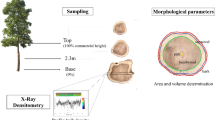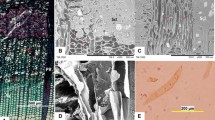Abstract
Timber quality and value could be reduced by the emergence and persistence of epicormic formations in Quercus petraea. Apart from epicormic branches, little information is available on other epicormic formations such as clusters of buds and burrs. We propose a classification based on a description of epicormic formations’ shape and the dimensions of traces developed in the wood. This enabled us to understand their ontogeny and their relationships, and to evaluate defects formed in the wood. The final classification contains four types: (1) type b characterised by a shoot stump with a diameter less than 15 mm, either bearing or not bearing buds; (2) type g comprising thin epicormic shoots (diameter <15 mm) without epicormic buds at their base; (3) type bt comprising a group of thin epicormic shoots (<5 mm diameter) and epicormic buds borne either by a small shoot stump or directly from the trunk; and (4) type gt comprising thick epicormic shoots (diameter >15 mm) bearing buds and/or epicormic shoots at their base. We propose the following relationship between the different types of epicormic formations: an epicormic bud develops into a thin shoot (type g), the shoot can either partially die and induce a cluster of buds (type b) which then give rise to type bt, or survive and form an epicormic branch (type gt). In parallel, we show that defects increase from type g to type gt. Type g induces minor defects since the knots in the wood are small, sound and single, whereas type gt produces major defects with knots that are generally large, rotten and grouped.







Similar content being viewed by others
References
Blum BM (1963) Excessive exposure stimulates epicormic branching in young northern hardwoods. USDA Forest Service Research Note 9. USDA, Washington, pp 1-6
Bryan J, Lanner R (1981) Epicormic branching in Rocky mountain Douglas-fir. Can J For Res 11:190–199
Church TW Jr, Godman RM (1966) The formation and development of dormant buds in sugar maple. For Sci 12:301–306
Constant T, Mothe F, Badia MA (2003) How to relate the standing tree shape to internal wood characteristics: proposal of an experimental method applied to poplar trees. Ann For Sci (in press)
Courraud R (1987) Les gourmands sur les chênes rouvre et pédonculé. For Entreprise 45:20–33
Dale ME, Sonderman DL (1984) Effect of thinning on growth and potential quality of young white oak crop trees. USDA Forest Service Research Paper. NE-539. USDA, Washington, pp 1–12
Evans J (1983) Le contrôle des gourmands: état actuel des recherches en Grande-Bretagne. Rev For Fr 35:369–375
Fontaine F (2000) Les formations épicormiques (bourgeons et gourmands) chez le chêne sessile. Association entre les formations épicormiques présentes sur le tronc et les traces laissées dans le bois. ONF, Paris
Fontaine F, Druelle JL, Clément C, Burrus M, Audran JC (1998) Ontogeny of proventitious epicormic buds in Quercus petraea. I. In the 5 years following initiation. Trees 13:54–62
Fontaine F, Kiefer E, Clément C, Burrus M, Druelle JL (1999) Ontogeny of the proventitious epicormic buds in Quercus petraea. II. From 6 to 40 years of the tree’s life. Trees 14:83–90
Fontaine F, Colin F, Jarret P, Druelle JL (2001) Evolution of the epicormic potential on 17-year-old Quercus petraea. Ann For Sci 58:583–592
Godman RH, Books DJ (1971) Influence of stand density on stem quality in pole-size northern hardwoods. USDA Forest Service Research Paper. NC-54. USDA, Washington, pp 1–7
Hartig T (1878) Anatomie und Physiologie der Holzpflanzen. Springer, Berlin Heidelberg New York
Jemison GM, Schumacher FX (1948) Epicormic branching in old-growth Appalachian hardwoods. J For 46:252–254
MacDaniels LH (1953) Anatomical basis of so-called adventitious buds in the apple. Cornell Exp Stat Mem 325:2–22
Miller GW (1996) Epicormic branching on central Appalachian hardwoods 10 years after deferment cutting. USDA Forest Service Research Note 702. USDA, Washington, pp 1–9
Nicolini E, Chanson B, Bonne F (2001) Stem growth and epicormic branch formation in under storey beech trees ( Fagus sylvatica L.). Ann Bot 87:1–15
Rey-Lescure E (1982) Distribution des gourmands sur les fûts de 25 essences en bordures de déboisement. Can J For Res 12:687–698
Smith HC (1966) Epicormic branching on eight species of Appalachian hardwoods. USDA Forest Service Research Note 53. USDA, Washington, pp 1–4
Smith HC (1977) Changes in tree density do not influence epicormic branching of yellow-poplar. USDA Forest Service Research Note. NE-239. USDA, Washington, pp 1–3
Sonderman DL (1984a) Quality response of 29 year-old, even-aged central hardwoods after thinning. USDA Forest Service Research Paper. NE-546. USDA, Washington, pp 1–9
Sonderman DL (1984b) Quality response of even-aged 80-year-old white oak trees after thinning. USDA Forest Service Research Paper. NE-543. USDA, Washington, pp 1–6
Sonderman DL (1985) Stand density. A factor affecting stem quality of young hardwoods. USDA Forest Service Research Paper. NE-561. USDA, Washington, pp 1–8
Spiecker H (1991) Zür Steuerung des Dickenwachstums und der Astereinigung von Trauben und Stieleichen ( Quercus petraea (Matt.) Liebl. und Quercus robur L.) Schriften Landesforst 72:150
Strong TF, Erdmann GG (2001) Effects of residual stand density on growth and volume production in even-aged red maple stands. Can J For Res 30:372–378
Trimble G, Seegrist DW (1973) Epicormic branching on hardwood trees bordering forest openings. USDA Forest Service Research Paper, NE-261. USDA, Washington, pp 1–6
Wignall TA, Browning G (1988) The effects of stand thinning and artificial shading on epicormic bud emergence in pedonculate pedunculate oak ( Quercus robur L.). Forestry 61:45–59
Acknowledgements
The authors wish to thank the ONF for providing the material and the for financing of this work, INRA technicians Bruno Garnier and Daniel Rittié for technical help, and Mike Badia (PhD) and Thiery Constant (wood scientist) for advice on processing the 3D-images.
Author information
Authors and Affiliations
Corresponding author
Rights and permissions
About this article
Cite this article
Florence, F., Frédéric, M., Francis, C. et al. Structural relationships between the epicormic formations on the trunk surface and defects induced in the wood of Quercus petraea . Trees 18, 295–306 (2004). https://doi.org/10.1007/s00468-003-0306-7
Received:
Accepted:
Published:
Issue Date:
DOI: https://doi.org/10.1007/s00468-003-0306-7




